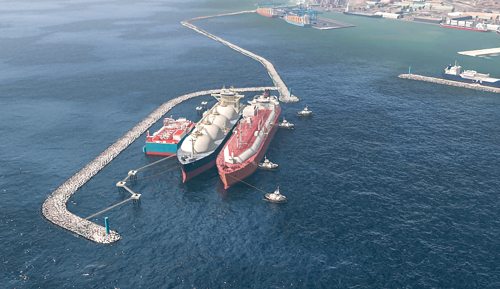Regional Focus: Developing LNG infrastructure for West Africa’s gas-to-power push
In West Africa, governments have embraced the use of gas as a low-carbon fuel to increase electricity generation, which is creating additional demand for LNG. Although Africa has substantial gas reservoirs, the needed LNG supply is presently sourced from the international market as leading producers in the region grapple with supply challenges. These challenges can be partly solved, however, through investment in modern gas storage facilities.
Natural gas production is still in its infancy in Ghana, Senegal and Côte d’Ivoire. Gas storage infrastructure, especially underground storage, has not yet been achieved since gas reservoirs in producing countries have not yet been depleted. This means that West African nations’ gas-to-power campaigns require other forms of gas storage to ensure support for electricity generation that, at the moment, relies heavily on imported LNG.
Advancing LNG infrastructure in West Africa. Investment in LNG import infrastructure is an emerging trend in West Africa as leading natural gas producers such as Nigeria, Ghana, Côte d’Ivoire, Senegal, Equatorial Guinea and Benin grapple with challenges that have constrained the consistency of their gas production.
The region’s natural gas producers are still courting international oil companies with opportunities in their upstream spaces, but production has remained inadequate to support increased power generation requirements. This has led to a shift in focus to the construction of LNG regasification and storage facilities.
For example, Nigeria, Côte d’Ivoire, Ghana and Senegal—the leading gas-to-power markets in West Africa—have plans to generate a combined additional 7,759 MW of power from gas by 2030, of which 2,222 MW is projected to come online by 2025. To realize this plan, the countries’ governments have entered into agreements with international gas suppliers to supplement their inadequate domestic supply. They have also drawn up LNG storage projects to meet the seasonal demand expected from end users, such as electricity generation plants and industrial users.
Ghana pushes ahead with Tema LNG. Ghana is targeting an additional 1,718 MW of power generation from gas by 2030. In partnership with the private sector, the government has invested in new commercial LNG import infrastructure, namely the Tema LNG import terminal (FIG. 1). At present, Ghana relies on the 678-km West African Gas Pipeline for its gas supply; however, the pipeline has a historically erratic supply trend due to payment disputes, technical issues and upstream gas supply issues with Nigeria.
 |
| FIG. 1. The planned Tema LNG import terminal offshore Ghana. Image courtesy of Tema LNG Terminal Co. |
The previous approval of a concession by Tema LNG Terminal Co. Ltd. (Tema LNG), a JV between Helios Investment Partners and Ghana National Petroleum Co. (GNPC), for the construction of an LNG import terminal was a major step in Ghana’s efforts to hedge available gas supplies for power generation. GNPC previously signed a 12-yr gas supply agreement with Rosneft Trading SA for the supply of 1.7 metric MMtpy of gas to serve the Tema region.
Under the supply agreement, GNPC will purchase LNG from Rosneft Trading for regasification and subsequent delivery to thermal independent power producers and industrial customers. In accordance with the plan, Rosneft Trading has signed an agreement with Tema LNG Terminal Co. for the development of a 240-MMsft3d LNG import terminal that will be linked to a floating storage unit (FSU) and a floating regasification unit (FRU). The FRU arrived offshore Ghana in early January 2021.
The Tema LNG terminal project was preceded by a similar deal between GNPC and Bermuda-based LNG shipping company Golar for the supply of 170,000 m3 of gas from the Golar Tundra FSRU to support Ghana’s LNG imports.
Côte d’Ivoire eyes FSRU. In Côte d’Ivoire, where gas is a critical part of the country’s energy mix, the government is working to fast-track modern LNG import infrastructure to regasify and store LNG for distribution to end users.
The country has an estimated 1 Tft3 of developed gas resources, but this is inadequate to meet demand; Côte d’Ivoire has an estimated gas deficit of 0.35 Tft3y. Additional gas must be imported, regasified, stored and distributed to support the planned generation of 1,271 MW of gas-fired electricity by 2030.
Earlier, French oil major Total led a team of partners to sign an agreement for the development of a 3-MMtpy LNG regasification terminal in Côte d’Ivoire. Other companies involved in the LNG project, in which Total is the operator with a 34% stake, include national firms PetroCI (11%) and CI Energies (5%), as well as SOCAR (26%), Shell (13%), Golar (6%) and Endeavor Energy (5%).
Total will supply up to 0.5 metric MMtpy of LNG for the regas terminal over a 15-yr period, making it possible for Côte d’Ivoire to integrate LNG supply and import infrastructure through an FSRU. A pipeline would connect the FSRU in the Vridi, Abidjan area to existing and planned power plants in Abidjan, as well as to regional markets connected to the Ivorian network. Total said the project will enable Côte d’Ivoire to become the first regional LNG import hub in West Africa and to meet both regional and domestic demand.
Other LNG and gas-to-power initiatives. Total is also developing an LNG import terminal in neighboring Benin. The project includes an FSRU and an offshore pipeline connection to existing and planned power plants in Maria Gléta. According to Total, Benin’s access to LNG will help the country meet growing domestic energy demand and add more natural gas to the country’s energy mix, thereby reducing its carbon intensity.
In Equatorial Guinea, a regasification plant to support the storage, transport and distribution of LNG across the country has been developed. The complex includes at least 12 bullet tanks with a capacity of 14,000 m3 of storage capacity. The regasification plant, located at the Akonikien port, is the first LNG storage and regasification plant in West Africa and falls under Equatorial Guinea’s government-led LNG2Africa initiative.
Meanwhile, an 84,100-m3 LNG storage tank is being developed in Nigeria as part of the $6.5-B Nigeria LNG Ltd. (NLNG) Train 7 project, which also includes a new liquefaction unit, a 36,000-m3 condensate tank and three gas turbine generators on Bonny Island. The development of gas storage facilities is a boost for Nigeria’s gas-to-power scheme, partly because of the uncertainty of gas supply from key producing areas, such as the Niger Delta, where frequent vandalism starves power plants of the needed gas. Nigeria selected a consortium comprising Saipem, Chiyoda and Daewoo as the EPC contractor for the Train 7 project.
One of West Africa’s smallest gas producers, Senegal, has made recent additional natural gas discoveries but is in need of infrastructure to support LNG imports for gas-to-power projects. With no new local gas production expected until 2025, Senegal has opportunities for LNG imports to ease its transition to gas while also reducing the cost of its electricity generation. GP
 |
SHEM OIRERE is a freelance journalist based in Nairobi, Kenya. He has spent more than 10 yr covering various sectors of Africa’s economy, and has had numerous articles published in several international publications and websites. He earned a higher degree in journalism from the London School of Journalism, and is also a member of the Association of Business Executives (ABE).




Comments